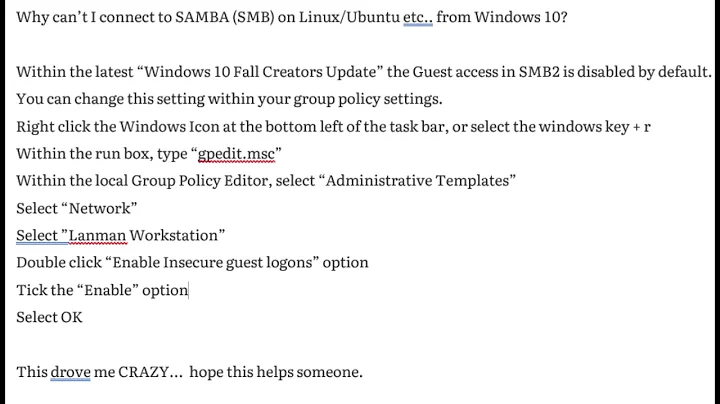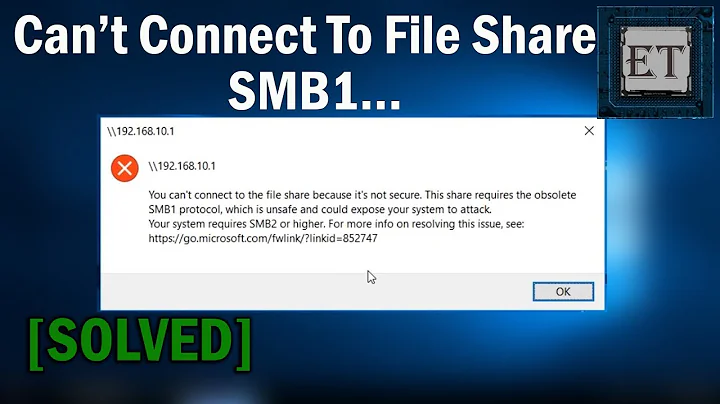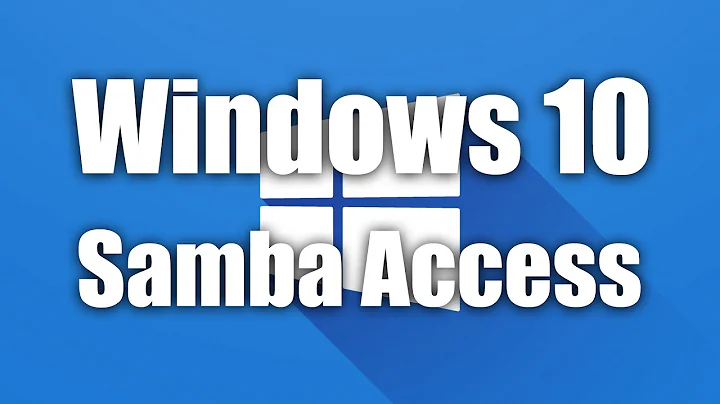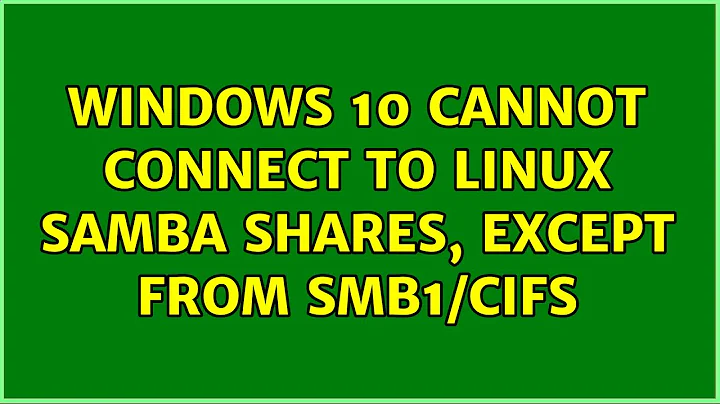Windows 10 cannot connect to Linux Samba shares, except from SMB1/CIFS
Solution 1
In my case (Windows 10, ancient Samba 4.2.10 on CentOS 6) what helped was setting the min protocol to SMB2, max protocol to SMB3:
[global]
min protocol = SMB2
max protocol = SMB3
client min protocol = SMB2
client max protocol = SMB3
client ipc min protocol = SMB2
client ipc max protocol = SMB3
server min protocol = SMB2
server max protocol = SMB3
And then connecting the share as a network drive (Explorer -> Home -> Easy access -> Map as drive), putting in the share name (\\1.2.3.4\ShareName), ticking "Connect using different credentials", then Other, and put in username in the format DOMAIN\username.
When trying to get to the share in Explorer, it would never ask for credentials, nor was I able to specify the username with net use \\shareserver\data /user:testuser (got System Error 58).
Solution 2
Running smbpasswd -a user is crucial here!
My running smb.conf:
[global]
client max protocol = SMB3
name resolve order = wins lmhosts host bcast
security = USER
username map = /etc/samba/smbusers
idmap config * : backend = tdb
[rootfs]
create mask = 0644
force group = root
force user = root
path = /
read only = No
Related videos on Youtube
Comments
-
 gluttony over 1 year
gluttony over 1 yearI have an issue under Windows 10 to access some Linux Samba shares with following error:
Check the spelling of the name. Otherwise, there might be a problem with your network. To try to identify and resolve network problems click Diagnose. Error code: 0x80070035 The network path was not foundI can successfully browse from an old openSUSE 12.1 that uses only SMB1/CIFS but not from a more recent openSUSE Leap 15, except if I force NT1 protocol (that is for SMB1/CIFS) on its side, in /etc/samba/smb.conf global section:
[global] ... min protocol = NT1 max protocol = NT1For information, by default min protocol is LANMAN1 and max protocol is SMB3, that range then includes NT1 protocol (see SMB protocol min max values available?):
$ testparm --parameter-name="min protocol" [...] LANMAN1 $ testparm --parameter-name="max protocol" [...] SMB3And I can access these shared folders from another Linux computer without forcing protocol with following command for example I can list folders:
smbclient -L MyLeap15Computer -NOr connect to tmp shared folder with:
smbclient //MyLeap15Computer /tmp -NI also confirmed that SMB2 and 3 are actually active with How to detect, enable and disable SMBv1, SMBv2, and SMBv3 in Windows, and also been able to access them from another Windows 10. And from the computer on which I cannot access them I successfully ping MyLeap15Computer.
Anyway, technically I can access my shared folders by forcing NT1 protocol, but since it should be possible I want to be able to access them from SMB2 or SMB3 since there are security issues in SMB1/CIFS (and then deactivate it in Windows 10 too), also, since I can access them from another Windows 10 without forcing this protocol it then should be something in Windows configuration but I cannot manage to see which since everything appears active on both.
And finally, even if issue seems to be more on client side, here is the server condifuration, /etc/samba/smb.conf without forcing to NT1 protocol (this configuration accepts guest users, then no credentials have to be given for connection):
[global] workgroup = WORKGROUP passdb backend = tdbsam printing = cups printcap name = cups printcap cache time = 750 cups options = raw map to guest = bad user logon path = \\%L\profiles\.msprofile logon home = \\%L\%U\.9xprofile logon drive = P: usershare allow guests = yes usershare max shares = 100 winbind offline logon = yes winbind refresh tickets = yes create mask = 777 directory mask = 777 delete readonly = yes [tmp] comment = Temp folder path = /tmp browseable = yes writable = yes read only = no guest ok = yes mangled names = noEdit: here are more information after what suggested @JW0914, what was suggested did not work but I found something interesting in server logs (added log level = 3 to /etc/samba/smb.conf global section then looked on /var/log/samba/log.smbd after having tried connection):
check_ntlm_password: Checking password for unmapped user [DOMAIN]\[USER]@[Windows10Computer] with the new password interface [2020/02/05 14:21:23.845849, 3] ../source3/auth/auth.c:192(auth_check_ntlm_password) check_ntlm_password: mapped user is: [DOMAIN]\[USER]@[Windows10Computer] [2020/02/05 14:21:23.845879, 3] ../source3/auth/check_samsec.c:399(check_sam_security) check_sam_security: Couldn't find user 'USER' in passdb. [2020/02/05 14:21:23.845890, 2] ../source3/auth/auth.c:332(auth_check_ntlm_password) check_ntlm_password: Authentication for user [USER] -> [USER] FAILED with error NT_STATUS_NO_SUCH_USER, authoritative=1 [2020/02/05 14:21:23.845910, 2] ../auth/auth_log.c:760(log_authentication_event_human_readable) Auth: [SMB2,(null)] user [DOMAIN]\[USER] at [Wed, 05 Feb 2020 14:21:23.845900 CET] with [NTLMv2] status [NT_STATUS_NO_SUCH_USER] workstation [Windows10Computer] remote host [ipv4:172.168.0.69:56937] mapped to [DOMAIN]\[USER]. local host [ipv4:172.168.0.99:445] [...] No such user USER [DOMAIN] - using guest account [2020/02/05 14:21:23.847182, 3] ../source3/smbd/server_exit.c:244(exit_server_common) Server exit (NT_STATUS_CONNECTION_RESET)I see server is trying to authenticate with user logged in Windows 10, but since not existing it falls back to guest user but connection is reset just after. In the other side, with a computer for which it is working, when logged with same domain/user and accessing successfully I have quite the same logs (different computer name and IP) but at the end:
No such user USER [DOMAIN] - using guest account [2020/02/05 14:43:21.147396, 3] ../lib/util/access.c:365(allow_access) Allowed connection from 192.168.0.77 (192.168.0.77)I'm looking into it but I would be glad if anybody has a clue on what is happening.
Edit2: after a quick look I found a workaround on Windows 10 fall update and samba guest account but when trying net use command I have following issue, then this is my company that may have change security on newer computer (both used are on the same domain but the one not working comes from a newer installation):
You can't access this shared folder because your organization's security policies block unauthenticated guest access. These policies help protect your PC from unsafe or malicious devices on the network.Thanks
-
JW0914 about 4 yearsFirst, disable SMB1 via
WinKey+R:OptionalFeatures> Ensure every box under, and including, SMB 1.0/CIFS File Sharing Support is unchecked > OK > Reboot. Please then issue the following (in order listed) to rule out system file corruption/dirty Component Store:DISM /Online /Cleanup-Image /StartComponentCleanup>DISM /Online /Cleanup-Image /RestoreHealth> Reboot >SFC /ScanNow> Reboot. Install SMB Direct viaOptionalFeatures> Reboot. Retry accessing share & if unsuccessful check Samba server log (logging may need to be enabled/verbosity increased). Are you on v1909? -
 gluttony about 4 years@JW0914: thanks for your answer, it is still not working but I have more information with server logs, I edit my question with that and search around this in parallel.
gluttony about 4 years@JW0914: thanks for your answer, it is still not working but I have more information with server logs, I edit my question with that and search around this in parallel.
-
-
Jasper about 2 yearsWorks like a charm!




